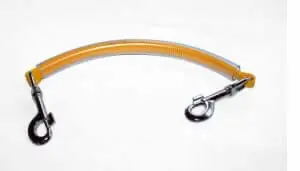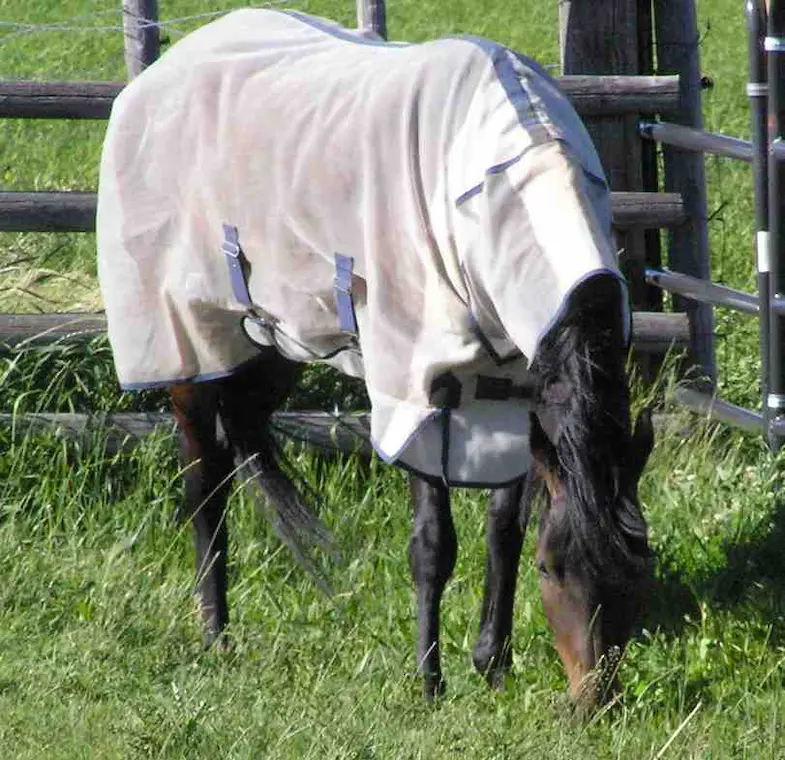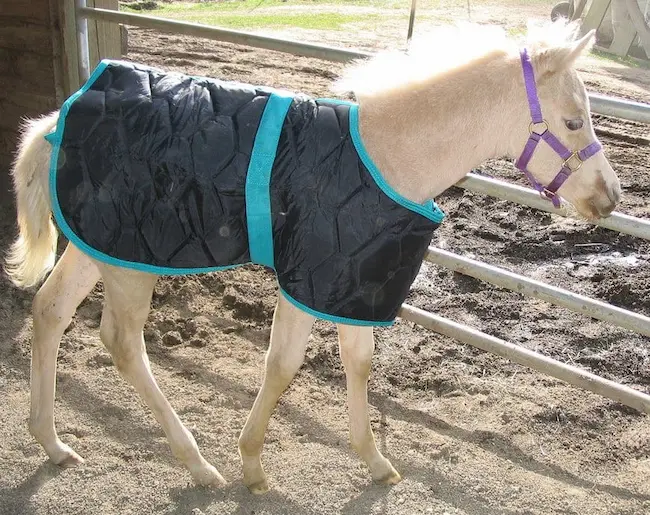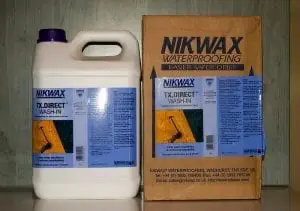These days there are a thousand and one (okay not literally) different types of blankets for horses but are they all needed or can you have just a few? When I bought my first horse buying a blanket was pretty easy, I had a jute blanket, a summer blanket, and an anti-sweat blanket! I have to confess that back then I wasn’t exactly sure what was what so if I’d had more choice then I would have found it even more concussing. This is why I thought I’d write this article about blankets to try and help if you’re in the market for a new blanket.
Does my horse really need a blanket?
You don’t necessarily always need to blanket your horse. When you do is largely dependent on the temperature, whether or not your horse is clipped, and if he’s stabled or turned out. I’ve tried to explain it in more detail in the table below but as a general rule, unclipped horses don’t need a blanket if the weather is 50 (or 10C) or higher and all horses need a blanket if it’s colder than 14 (-10C). In between those temperatures, your horse will need a range of different blankets depending on whether he’s stabled or turned out and whether his coat has been clipped.
| Temperature (F/C) | Clipped & stabled | Clipped & turned out | Unclipped & stabled | Unclipped & stabled |
|---|---|---|---|---|
| Above 60 / 15 | Zero fill | – | – | – |
| 50 to 60 / 10 to 15 | Light weight – zero to 100g fill | No blanket or zero fill | – | No blanket unless wet & windy then zero to 100g fill |
| 40 to 50 / 5 to 10 | Medium weight – approx. 250g | Light weight – approx 150g | No blanket or light weight – approx 150g | Light weight with neck cover – approx 150g |
| 30 to 40 / 0 to 4 | Heavy weight – approx. 300g | Medium weight – approx. 200g | No blanket or light to medium weight – approx 150g to 250g | Medium weight with neck cover – approx. 200g |
| 30 to 15 / 0 to -10 | Heavy weight, with neck cover – 300g to 400g | Medium weight with liner – approx. 200g to 300g | Light or medium weight with neck cover – 150g to 300g | Heavy weight, with neck cover and liner – 300g to 400g |
| Colder than 15 / -10 | Heavy weight, with neck cover and liner – approx 500g | Heavy weight, with neck cover – 300g to 400g | Heavy weight, with neck cover – approx 500g | Heavy weight, with neck cover and liner – 300g to 500g |
Is there a difference between blankets?
Years ago a lot of people only had an all-purpose jute blanket that they could use on its own or with blankets underneath if the weather turned cold. These days there’s a different blanket for every season of the year but despite that most of these blankets do fall into one of eight categories:
- Fly – Made from a lightweight mesh material these can be used during the summer months to give the horse some protection from insect bites during the hotter months.
- Cooler – As the name suggested these are used to help cool your horse down exercise. They allow moisture to evaporate and the horse to cool down gradually. You can also use a cooler blanket after you’ve washed your horse.
- Exercise – Not essential, these are designed to keep your horse dry and warm while being ridden. They can be used under or over the saddle.
- Fleece – Ideal as a travel blanket fleece blankets are lightweight and can also be used as a light stable blanket or as an under blanket if the weather is exceptionally cold. Despite their ‘warm’ sounding name fleece blankets make a good substitute for a cooler blanket. Fleece blankets are sometimes referred to as combo blankets.
- Stable – Varying in weight and thickness stable blankets aren’t waterproof so should only be used while the horse is stabled.
- Summer – Similar to the fleece blanket, the summer blanket is usually made from cotton and is extremely lightweight.
- Sweet Itch – Similar to a mosquito net these blankets are made from an ultra-fine mesh blanket and greatly reduce a horse’s chance of being bitten by gnats, which is the main cause of sweet itch.
- Turnout – As you would expect by their name these blankets, which come in a variety of different weights and thicknesses, are waterproof and are designed to keep your horse warm and dry while he’s turned out.
What size blanket does my horse need?
To make sure you get the right size blanket for your horse you need to measure him (as a general rule are measured in centimeters, inches, and feet). Where you measure him from though is dependent on where you are and where you’re buying the blanket from. If you’re in the US, UK, or Australia then you need to measure the horse at the bottom, from the center of his chest to the rear. On the other hand, you’re in Europe then you measure the horse from the top, starting at the withers and stopping at the tail.
How do I fit a horse blanket?
A properly fitted blanket should cover your horse’s entire body, it shouldn’t be too tight, and nor should it slip about. If it’s too tight then it can rub and hurt your horse, while if it’s too loose then there’s a risk of it slipping and getting caught which could be very dangerous. When it comes to fitting a blanket there are a few questions you should ask.
- Can my horse move? – A well-fitted blanket should have enough room at the front to allow the straps/buckles to be fastened without pressing on his chest. To check this make sure that, after fastening it, you can comfortably get your hand inside the blanket and around the shoulders and chest.
- Does it sit well? – There should be between 2in and 4in of blanket covering the withers, this will prevent any pressure from being put on them. The back of the blanket should also comfortably reach the tail, if it doesn’t then it won’t protect your horse from the elements properly.
- Does it cover him properly? – You shouldn’t be able to see any of his stomach under the blanket, if you can then he’ll be exposed to the elements. Also, check that the surcingle fits correctly. Most surcingles can be adjusted so make sure you can easily fit your hand between your horse and the strap.
- If you have a neck cover does it cover the neck? – This might sound like a really silly thing to say but make sure that it covers the whole neck, even while he’s eating. Also, make sure that it’s not too tight as it’ll cause rubbing and soreness on the mane.
When putting a blanket on your horse it’s better to position it higher than it is to position it lower. The reason for this is because if it’s too high you can pull it back until it’s in the right place. Whereas if you end up putting it on too low down then you’ll have to pull it upwards, this would also pull his fur up and over time become very uncomfortable. If you do find it’s too low you’d better off removing it and starting again.
Can I put my horse’s blanket in the washing machine?
You may be surprised to know that while many blankets can’t be put in your washing machine at home some of them can. Most blankets will come with the manufacturer’s cleaning instructions which will tell you if they can be machine-washed or not. If they can then it’s important to follow the instructions they came with and the manufacturer will have tested them thoroughly to make sure you get the most out of your blanket. As a general rule though it tends to be the lighter ‘summer type’ blankets that can be machine-washed.
How do I clean my horse’s blanket?
When it comes to cleaning blankets it’s pretty easy really. To start with you should remove all of the straps and anything else that can be removed, these can then be put in a washing machine although it’s advisable to put them inside a wash bag.
When it comes to cleaning the actual blanket you can make it easier for yourself it’s best to lay the blanket over a fence, this will save you from having to bend so much. Next, take a sturdy brush to remove all of the mud and dirt from the outside of the blanket. After this turn the blanket inside out and if you have a handheld vacuum you can go over the lining of the blanket first. Don’t worry if you don’t just use a brush to remove all of the hair from it. Once you’ve brushed as much of the dirt as you can from both sides you can then wash it.
To wash your blanket you’ll need to use a large bucket or bin filled with hot soapy water. Make sure you use non-bio washing powder though and add a little bit of detergent-free soap to help protect the waterproof layer. Put the whole blanket in the water and use a clean broom handle to mix the water and blanket around before leaving it to soak for a little while.
After around ten minutes remove the blanket and lay it flat on the floor and, using a clean hard bristled brush (or a broom if it’s easier), remove any marks or stains that were left after washing. To dry the blanket you can hang it on a blanket rack or drier. If you don’t have a drier though you can put it back over the fence to let the air dry it.
If you don’t like the idea of cleaning the blanket yourself or are worried about doing it don’t worry there are plenty of professional blanket cleaners who would be more than happy to do it for you. If needed they will re-proof the blanket for you and will often carry out any minors too. Your local saddlery should be able to provide you so a few professional cleaners or if not a quick search online would give you the details of people near you.
What’s the best way to look after my horse’s blanket?
If you look after your blanket it’ll last you for many years, washing is, of course, one way to look after it but you should also look after it in-between washes. You should regularly check your blankets for signs of damage, this is especially important for turnout and exercise blankets. Make sure there are no tears or holes in them. If you do find a small tear then you can either sew it up or if it’s a turnout blanket glue a repair patch over it. If you use a repair patch always use around twice a much material as the hole, for example, if you have a tear that’s an inch make sure you use a two-inch piece of material. This will help it to stick better and will also offer better protection and it also prevents the original hole from fraying. Don’t forget to also add waterproofing to the repair.
If your blanket is wet then don’t put it away. This might sound like the most obvious thing to say but be honest have you ever thought to yourself ‘that’s almost dry, it’ll be okay’? I know that I certainly have, only to find mold on it when I come to use it again. I know it can look unsightly to have blankets hanging up but in the long run, it’s better for the blanket to make sure it’s dry.
How do I store my horse’s blanket?
There’s no right or wrong way to store blankets, except to say they should be dry first! Everybody has a different solution for storing blankets but there are plenty of ‘off the shelf’ options.
- Blanket rack – Either free-standing or wall hanging these can store multiple blankets out of the way while also allowing easy access to them when needed.
- Storage bag or box – Storage bags and boxes are pretty much the same thing except the bag has a softer exterior while the box has a more rigid surrounding. These are designed to store a number of folded blankets.
- Vacuum bag – This option is my favorite, and I always use it to store my winter blankets in the summer and summer blankets in the winter. Put each blanket in separate a bag and then use a vacuum to remove all of the air. This has the double benefit of protecting the blankets from moths while removing the air shrinks the bags down and makes them even easier to store.
Jargon explained
When I had my first horse I was baffled by some of the names of various parts of the blanket, things like ‘fillet string’ always made me laugh. The trouble was I didn’t want to look silly so didn’t ask what it was, which is why I thought it would help to explain some of the more unusual blanket terminologies.

- Fillet string – Running under the horse’s tail the fillet string prevents the blanket from blowing about when it’s really windy as well as helping to keep it in place while your horse is rolling.
- Surcingle – This is the strap that runs underneath the horse to keep the blanket in place.
- Filling – Measured in grams, the higher the number the warmer the blanket is.
- Denier – Similar to tights this refers to the thickness of the blanket. The higher the deer the tougher the fabric is.
- Rip-stop – This means that the material of the run runs in two directions which will help prevent any tears from spreading.
- Waterproof – As you would expect this refers to the outer layer of the blanket, over time the waterproof layer will finish and need to be re-proofed.
- Breathable – This refers to the blanket’s ability to remove sweat and moisture wot wick away.
- Taped seams – Waterproof taping is applied over the seams to prevent water from getting in through the holes made by the needle when the seams are sewn together.
- Standard neck – blankets with a standard neck stop at the horse’s withers and leave the neck uncovered.
- High neck – Unlike a standard neck these go beyond the withers but cover the entire neck.
- Detachable neck – This means that the blanket can have a neck cover attached to it. Some blankets will come with a neck cover but others will have to be bought separately.
Conclusion
Some people argue that horses live out in the wild naturally without any problems and while that’s true in the wild they’re not ridden, clipped, or stabled. So while wild horses don’t need a blanket today’s domestic horse is far removed from their wild ancestors in lots of ways. That doesn’t mean you need to wrap them from head to toe in a blanket all of the time though. Just remember they can’t deal with the elements in the way their wild counterparts can.
I hope you found this article helpful. If you did I’d be grateful if you could share it please as it would really help me.
Recommended products
Over the years I have tried hundreds of different horsey products, from various blankets and halters to different treats. Some I’ve loved, others I’ve hated but I thought I’d share with you my top all-time favorite products, the ones I never leave the yard without. I’ve included links to the products (which are in no particular order) that I really think are great.
- Horse Knots by Reference Ready – If you’re like me and enjoy pocket reference guides then you’ll love this knot tying guide. These handy cards can easily fit in your pocket or attach to the saddle for quick reference. They’re waterproof, durable and are color coded to make them easy to follow.
- Mane ’n Tail Detangler – Even if you never show your horse you’ll need to detangle his tail from time to time (and possibly his mane too) which is always a challenging chore! I’ve found that if I run a little bit of detangler through my horse’s tails every few days it stops them from getting matted up and makes combing them easy, even if they’re coated in mud. I don’t know if I should admit to this or not but it also works wonders on my hair.
- TAKEKIT Pro clippers – Over the years I’ve tried a lot of different clippers and while some were obviously better than others I found these to be by far the best. They are heavier than a lot of other clippers but for me, that’s a good thing, it makes them feel more sturdy and hardwearing. On top of that they have a range of speeds so are just as good for clipping your horse’s back as they are his face. I also like the fact that they come in a handy carry case but that’s not for everybody. The company that makes them is super good and incredibly helpful too, a real bonus these days. The only thing I wasn’t keen on was the fact that it doesn’t come with any oil, but that’s not a major problem as it’s not difficult to buy lubricant.
- Shire’s ball feeder – There are so many boredom buster toys out there but I like to use these every day, regardless of whether or not my horses are bored. I find that it helps to encourage my horses to problem solve by rewarding them with treats (or pieces of fruit) but it also mimics their natural grazing behavior which helps to keep them calm and de-stressed.
- Horse safe mirror – This is a strange one that many people are surprised about but I like to put horse safe mirrors in the trailers as well as in the quarantine stalls. It helps to prevent the feeling of isolation by giving the impression of other horses being around. Being herd animals horses can get extremely stressed when they feel that they’re on their own but with these stick-on mirrors, they believe that at least one other horse is with them.
- Rectal thermometer – I know this isn’t glamourous at all but it’s vital for your horse’s well-being to be able to check their temperature and a rectal thermometer is the easiest way of doing this which is why I’ve added it to the list.
Shopping lists
I’ve also put together a few shopping lists of essential items that I’ve found helpful over the years. I’ve broken the lists down into different categories rather than put everything in one massive list 😉



